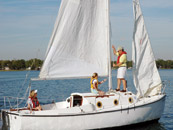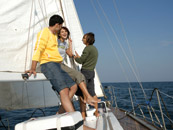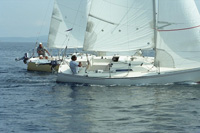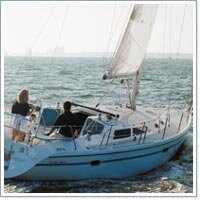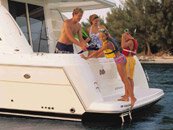By Tony Rey
In How to Make the Most of the Least, Part I, we outlined the keys to a winning strategy on a light-air run: sail in the maximum windspeed on the racecourse, stay on the long jibe, avoid the middle of the track if possible, and keep the boat moving fast at all times.
Sounds simple enough, right? In reality, however, your race track is probably congested with numerous competitors who all have the same idea. So weâll also explore tactical concepts that will help you implement your winning light-air strategy.Â
Keep it clean
It is impossible to sail at optimum speed in light wind if youâre sailing in wind disturbed by another boat, aka dirty air. On a light-wind run, the best way to tell if your breeze is clean is to look at your masthead fly, or shroud telltales, which will give you an indication of where your apparent wind is coming from. If you donât have a masthead fly, get one.
If the area at which your masthead wind indicator or telltale is pointing is clear of other boats then your lane is probably clean. Generally speaking, the bigger the boat, the longer and wider the wind shadow will extend to leeward.
If there is a windward opponent just aft of your lane of breeze, you should be OK, provided he is going the same speed. If heâs just forward of where your masthead fly is pointing, the exhaust from his sails is likely spoiling your clean air.
Donât get sucked up
A large percentage of light-air runs start with a similar scenario, with the fleet extending away from the windward mark in a line on starboard tack. The first priority for virtually every boat is to exit the mark with a clean lane. The second priority is to keep it that way.
If everyone behaves themselves, and sails their best VMG angle, it can be an orderly procession to the layline. But inevitably, the trailing boats will sneak high and threaten the clean air of the boats in front.
How these leading boats react separates the top teams from the average ones. When an average tactician hears the bubbling bow wave of the boat behind, he will often panic and reach up until he finds a massive clearing to windward. This will assure him of clear air, but the lateral distance, or gauge, sacrificed in the process will often prove more costly further down the run.
If the boats behind you start sailing high, and you are comfortable that you are already sailing your optimum angle, resist the urge to go up with them. They may be defending against boats behind them. Eventually everyone will settle into their preferred downwind angles. At that point, you will have made a nice lateral gain by not taking the bait.
If the boats to windward are moving fasterâmaybe they are faster, or bringing more pressure with themâyou may need to head up to defend your lane. Good separation to leeward is valuable, but not as valuable as a clean lane.
Sometimes, no matter what you do, you will get rolled. Once youâve recognized that there is nothing you can do to prevent another boat sailing onto your breeze, limit the damage by jibing away before it happens, or, if it is imperative to remain on that jibe, by reaching up sharply after your opponent rolls over top to defend against the next boat flying by. The correct call should be based on your overall strategyâwhere is the best pressure, and which is the long jibe to the leeward mark? In this windspeed, sitting in bad air downwind is a slow death.Â
Beware the snowfence
What if you prefer the other side of the track, and your winning strategy calls for a quick jibe right at the mark? In a stronger breeze, this maneuver is relatively simpleâpick your spot, jibe, and take care not to foul any boats sailing upwind.
In a superlight breeze, this exit must be planned with care. A wall of starboard-tack boats sailing upwind on their layline will have a snowfence effect on the breeze, preventing it from filling into the top right side of the racetrack. A jibe at or just after the mark will have you sailing through some tragically disturbed air. Itâs generally wise to wait a few minutes. The fleet will have rounded the mark and youâll be able to get your own boat settled and sailing fast. Watch the breeze on the water to determine how bad the snowfence is.
This snowfence effect can be created by a pack of boatsâsailing upwind or downwindâanywhere on the course. If possible, sail on the windward side of packs.
Pack with care
There is an adage among the old salts in the Etchells fleet that you rarely see a group of them going fast in light air. From my experience, this holds true with any class. Among the boats in a pack, itâs likely that, in order to keep their respective air clean, many will not be sailing the fastest VMG angle. This often has a domino effect and the majority of boats in the pack will be sailing too low or too high. Additionally boats in a pack are also sailing in disturbed water, as well as disturbed air. Sometimes being part of a clump is unavoidable. If thatâs the case, make sure your lane is clear, at the minimum.
When to jibe
If the run is remotely parallel to the wind direction, you will have to jibe at least once.
In very light wind, calling the perfect layline from a distance is difficult, because your sailing angle changes dramatically with every puff and lull. You can estimate your course on the other jibe by subtracting your average true wind angle from 180, doubling the result, and then either adding that number to your current heading, if youâre on port, or subtracting it, if youâre on starboard. A hand bearing compass is the best tool to sight the layline. If your true wind angle is 135 degrees, then youâre jibing through 90 degrees and anything perpendicular to the centerline of the boat will work.
If you are confident your lane on the opposite jibe will stay clean all the way to the mark, a jibe on layline could work well. But your strategy of staying in the pressure, and on the long jibe, is probably shared by most of your competitors, so quite often other boats will be thinking about jibing at around the same time.
So your decision when to jibe may be dictated more by the boats around you than the layline. This is where any extra distance gained to leeward before the jibe can pay off. If trailing boats are right on your transomâor worse, just to leeward of your lineâone of them may be able to match your jibe and camp on your air.
Conversely, if thereâs a boat just in front of you before you jibe, you may have an opportunity to jump onto his air in the maneuver. The ability to jibe quickly and efficiently, with little obvious preparation can really help on these light-air runs.
If you have the room to spare before the layline, and it looks like the boats behind are preparing to jibe, delay your maneuver for a few boatlengths to ensure a clean lane on the opposite jibe. A good rule of thumb is to wait until you can see the flat transom of a boat that is crossing behind you on the opposite jibe. That way, after you do your 90-degree turn, he will be forward of 90 degrees, and hopefully your lane on port jibe will be clean.
If you are not sure you have enough room before the layline for the lane to open up, match jibes with the trailing boats or beat them to the punch with a stealth jibe.
Leave the gate with speed
In light air, the primary tactical priority for the leeward gate is speed preservation; the second is a clean exit toward the favored side of the next leg.
With larger boats that rely on momentum to get around the corners, itâs critical to set up for the easiest maneuver. Try to avoid the last-minute jibe, or the 180-degree button hook turn around the buoy, even if it means rounding the gate mark thatâs a little further downwind.
Plan your approach to either layline so that you are coming into the gate marks with maximum speed. However, donât ignore the importance of keeping your lane clean until the last possible moment. If you are racing in a big fleet, sailing out to the layline too early will make it easy for other boats to camp on your breeze.
The key to a clean exit is rounding the gate with the fewest boats immediately on your bow. This will allow you to sail at optimum speed and angle after the mark. If youâre unsure which gate is best, have a look over your shoulder to see how the approaching crowd of spinnakers will effect you as you round the gate and right after. Avoid sailing under a snowfence.
After all the hard work to pick the correct side of the gate and preserve your momentum, donât kill your speed with a poor turn. The standard wide-then-tight tactical turn may be the most overrated maneuver in sailing. A smooth, gradual turn with an easier speed build is nearly always preferable to the bat turn commonly executed at the leeward marks.
Be patient, be fast
There is nothing like watching a lot of boats seek their fortune on the other jibe to make you second guess your game plan. The high angles sailed in light air create large splits, and a small difference in pressure or angle can cause a rapid tumble in the standings between the top mark and the leeward mark. Itâs scary stuff.
In the end, there is no better tactic than good boatspeed. Finishing well in light air usually requires sailing in the maximum pressure, making minimal maneuvers, and thinking ahead to keep your lane clear on both jibes.
Shared with Permission from Sailing Worldâs July 2008 Issue.
Â
